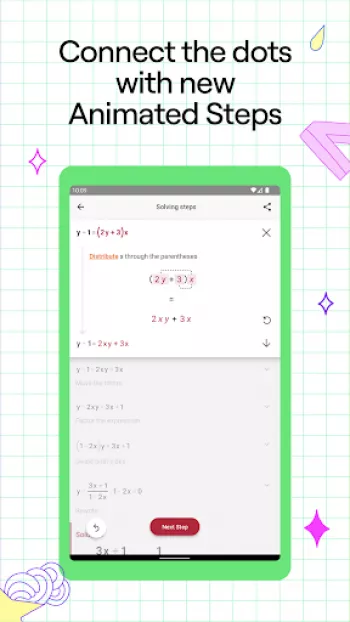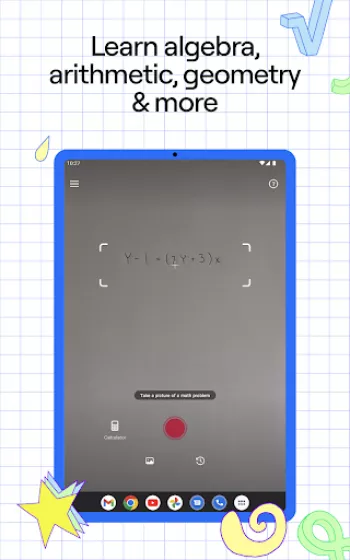Apps Home

The Evolution of Math Problem Solving Tools
In the ever-growing landscape of technology and education, the tools available for solving math problems have evolved in remarkable ways. From the use of simple calculators to sophisticated computer software, and now to highly intuitive applications on mobile devices, the trajectory of innovation in this field is staggering. Historically, math problem-solving involved manual calculations, relying on one's cognitive ability to compute and conceptualize abstract mathematical ideas. As education systems advanced, the advent of devices like the slide rule and later the electronic calculator revolutionized the ability for individuals to tackle complex mathematical problems more efficiently. Yet, these tools only provided the answer without imparting a deeper understanding of the methodology involved. Enter applications like the Photomath app, which represents the next leap forward, bridging the gap between computational aid and educational enhancement. Unlike traditional methods which require the user to input data accurately to derive at a solution, Photomath allows users to simply take a picture of a handwritten or printed problem, leveraging optical character recognition (OCR) to interpret and solve the problem almost instantaneously. This software evolution caters not only to processing computational tasks but fundamentally alters how learners engage with math by providing step-by-step breakdowns of solutions. This approach not only aids in the immediate problem at hand but serves as a pedagogical tool, reinforcing learning by illustrating the logical flow of mathematical reasoning. Through platforms like Photomath, the capabilities of technology to transform education and equip learners with both the tools and the skills necessary to excel in mathematics are clearly manifest. By merging visual technology with sophisticated algorithms, these problems solvers are more than mere calculators; they are comprehensive learning devices that adapt to the constantly shifting demands of math education and its integration with technology.
Understanding the Core Functionality of Photomath
The core functionality of the Photomath app lies in its ability to demystify complex math problems through a simple yet profoundly effective mechanism. At the heart of the app is its robust image recognition technology, which uses sophisticated algorithms to read and interpret textual and numerical expressions from images captured through a smartphone camera. This functionality is built upon advanced optical character recognition (OCR) technology, which translates captured images into a digital format that the app can process. Once the image is analyzed, the app employs its comprehensive database of mathematical knowledge and algorithms to generate step-by-step solutions. This is not where its capacities end—it meticulously presents each step, breaking down the process into manageable parts that facilitate a fundamental understanding of the concepts involved. Photomath doesn't merely spit out answers; it offers exhaustive explanations that reveal the reasoning behind each progression, enabling users to learn the methods applicable, even in broader contexts beyond the initial problem. Additionally, Photomath’s functionality is augmented with interactive graphs and animated steps that provide a dynamic learning experience, clarifying abstract mathematical principles through visual demonstration. This feature makes it possible not only to engage students who learn better through visual methods but also to reinforce learning by directly showing how changes in one part of a problem might affect the solution’s outcome. Furthermore, the app’s inclusion of multiple solving methods offers users various perspectives on approaching a problem, fostering deeper understanding and flexibility in problem-solving approaches. The combination of these advanced features positions Photomath as a powerful educational tool that transcends traditional problem-solving methods by integrating cutting-edge technology with user-centered instructional design, creating an ecosystem where learners can thrive.
The Role of Photomath in Self-Paced Learning and Education
Photomath plays a pivotal role in modern education, especially in the context of self-paced learning which is becoming increasingly important in an era where personalized education is gaining traction. Its unique approach empowers learners to engage with mathematical concepts at their own pace, allowing them to explore and understand topics thoroughly before moving on to more advanced materials. This self-directed learning is facilitated by the app's ability to provide instant feedback and tailor content to meet individual learning needs. Photomath’s step-by-step explanations are particularly beneficial for learners who may not have immediate access to traditional tutoring resources. The app’s capacity to deliver a virtual tutor experience 24/7 ensures that learners can practice and perfect their skills whenever they choose, capitalizing on the convenience of technology to foster an empowering learning environment. The accessibility of detailed explanations lends itself to iterative practice—students can repeatedly engage with problems, reviewing each step until they have a firm grasp of the subject matter. Moreover, Photomath's variety of solution techniques allows for multiple angles of understanding, ensuring that students can find a method that resonates with their learning style, whether it be through visual aids, animated steps, or textual explanations. This adaptability is crucial in accommodating the diverse needs of learners who might require different forms of engagement to grasp complex mathematical concepts effectively. The broader educational value of Photomath is also seen in how it encourages analytical thinking and problem-solving skills, core competencies that are essential not only within academic settings but in countless real-world applications. By crafting a learning experience that is as supportive as it is instructive, Photomath exemplifies the potential for technology to make education more equitable and effective, paving the way for a new era of mathematics education.
Comparing Photomath with Traditional Learning Tools
Traditional learning tools have long been the cornerstone of mathematical education, offering structured content and exercises aimed at developing proficiency in various mathematical disciplines. These include textbooks, worksheets, and manual calculations, which demand significant time investment and often require external validation from educators or peers to ensure accuracy. However, traditional methods, while effective, often lack the adaptability to cater to the individual learning styles and paces of students. Photomath fills these gaps by providing real-time solutions and instructional content tailored to individual needs, offering a contrast to the one-size-fits-all approach of conventional methods. Unlike static textbook problems, Photomath dynamically interacts with learners, providing immediate feedback and alternative problem-solving methods, which can foster deeper understanding and retention. Additionally, the inclusion of multimedia elements such as interactive graphs and video tutorials offers a multisensory learning experience that is usually absent in traditional tools. The interactivity and instantaneity of these digital solutions address the needs of the digital age, where students often seek immediacy and engagement in their learning processes. While traditional tools are invaluable for grounding students in the rudiments of mathematical principles, in today's technologically infused educational landscape, a hybrid approach often yields the best results. By integrating Photomath with conventional resources, educators can take advantage of the strengths of both worlds: the rigor and thoroughness of traditional learning with the innovation and efficiency of technology-enhanced education. This integration not only aids in understanding complex mathematical concepts but also prepares students for a future in which digital literacy and adaptability are paramount. As such, Photomath stands as an exemplary model of how modern technology can complement traditional educational methodologies, enhancing their effectiveness and accessibility.
The Future of Math Education with Photomath
The future of math education is incredibly promising with applications like Photomath leading the charge in integrating technology within learning paradigms. As educational institutions across the globe continue to incorporate technology into their curricula, Photomath's role becomes ever more vital in facilitating accessible, effective, and personalized learning experiences. The app’s capability to instantly solve mathematical problems with comprehensive explanations transforms how educators and students approach math education, aligning teaching methods with the digital orientation of current and future generations. This synthesis of education and technology not only enhances learning efficiencies but also democratizes access to high-quality education resources, breaking down barriers imposed by socio-economic and geographic constraints. Looking ahead, the application of artificial intelligence and machine learning within platforms like Photomath could present further advancements in adaptive learning, where the app could more acutely tailor its content to the unique learning needs and paces of individual students, providing even more precise and impactful educational support. Additionally, as technology continues to evolve, the potential for increasingly sophisticated features—such as integration with augmented reality for interactive problem solving and embedding more interactive tutorials—can further enrich the learning experience, making mathematics an engaging and interactive endeavor. Download for Android, iPhone, or visit the official site for more platforms and details. As educators and learners adapt to these new opportunities, the fundamental approach to teaching and learning mathematics could undergo a significant transformation, resulting in a generation of students better equipped with the analytical and problem-solving skills necessary for navigating the complexities of the modern world.
Share Your Opinion
Your Email Will Not Be Published.
All Rights Reserved © Apps Home 2025




































A Google user
This app is godly. It automatically calculates the answer to the problem, shows its work, and graphs it. Recently, I had been struggling with a top...
Ava Kleven
This has helped me so much in Algebra especially since they provide each step to get to the solution so you can see where you messed up. They also ...
Molly Schwab
I genuinely love this app. mostly because it doesn't just tell you the answer. it breaks it down into steps. if you want a more in-depth explanatio...
Just a guy
Anytime where I feel like I messed up on a problem or just want to be safe, I check it with this. It has not failed me yet. I haven't bought the su...
A Google user
This is an excellent program for showing the solution to equations step by step, letting you see where your mistakes are. Each step can be broken d...